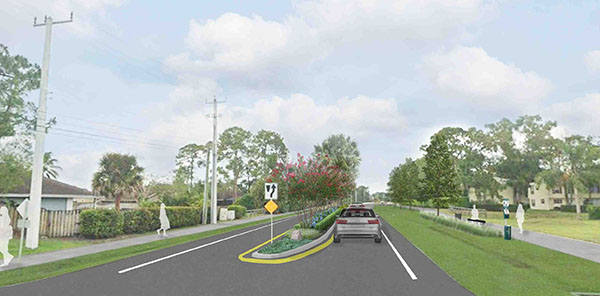A proposal to put landscaping and median islands along Wellington’s Big Blue Trace, presented as an effort to beautify the roadway and slow down motorists, sparked a range of questions from residents at a Wednesday, June 21 community forum.
Officials are seeking bids on the project to get a handle on its price, and ultimately it would need to go before the Wellington Village Council for approval, Village Manager Jim Barnes said.
The area affected would be Big Blue Trace from Paddock Drive near Wellington Elementary School to South Shore Blvd.
A primary goal is “corridor beautification,” village officials said in a presentation. That involves landscaping and irrigation. Another aspect would include pedestrian features, such as benches, trash receptacles and dog waste bags.
Finally, a key goal is “traffic calming,” including separating lanes traveling in different directions with median islands.
“Since we’re doing landscape medians, we decided why not try to slow the traffic down a little bit,” Village Engineer Jonathan Reinsvold said.
The idea is to encourage drivers to reduce speed because the lane gets narrower in landscaped sections with medians, he said.
In several places, that means 12-foot lanes temporarily constrict to 11-foot lanes. Curbs would appear on both sides of the lane, in cases where bushes and trees stand on both sides of the road, as well as the median.
The plan involves a total of six islands along the stretch of road, Reinsvold said.
Trees and larger vegetation are likely to include Verawood, Gumbo Limbo, Silver Buttonwood, Mukogee Crape Myrtle, South Florida Slash Pine and Southern Live Oak. Typical shrub plantings are expected to include Petra Croton, Red-Tipped Cocoplum, Imperial Blue Plumbago, Queen Emma Crinum Lily and Green Island Ficus.
Questions from residents included whether the plan will also include speed bumps, because if a driver is trying to make a left leaving a neighborhood, the vegetation can block some of the line of sight.
Speed bumps are not allowed on this type of “collector” road. They are approved only on local roads with speed limits of 25 mph or less, Reinsvold said. In this case, the speed limit is 40 mph.
A woman who said she regularly walks along Big Blue Trace expressed concern about landscaping blocking visibility for anyone crossing a road, and also introducing a worry that people or animals could be concealed in bushes to the side of the roadway. In addition, she wondered why the plan could not include more benches and landscaping near the elementary school, which experiences heavy vehicle and foot traffic at the start and end of school days.
Barnes said the village could look into whether there are better locations for the benches and other amenities, but he emphasized it is not a goal to support people crossing the road away from crosswalks.
“I would say we’re not going to do anything that would make it easier to do a mid-block crossing,” Barnes said.
Another resident question: Does this plan exclude creating four lanes for Big Blue Trace?
Barnes said an agreement with Palm Beach County does allow for a four-lane possibility, but it depends in part on traffic counts that to his knowledge have not come close to the necessary threshold. If four lanes came about in the future, he said portions of the proposed landscaping might have to be adjusted, but it could still happen.
Asked how long the project would take to construct if it goes ahead, Reinsvold said five months. Barnes said with weather delays and other likely issues, realistically it could be a bit longer than that.
One resident who was not in favor of the plan said Big Blue Trace already has been worked on many times in the last 15 years, but this plan does not address issues such as bicyclists on the main road making motorists try to go around them or slow down to a crawl behind them.
Multi-use paths on both sides of the corridor are intended to accommodate bicycles, even if not all cyclists choose to use them, officials said.
The next step in the project is to gather bids and learn more about what the project would cost.
“We’re then going to bring it to the council to see if they want to fund it,” Barnes said.
If approved, construction will likely not start before 2024, he said.








